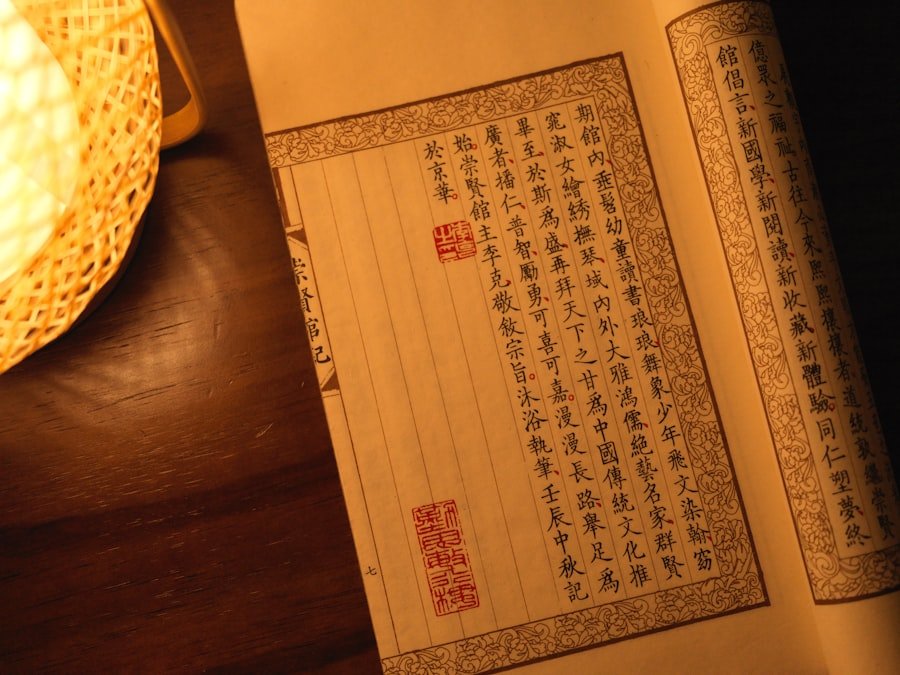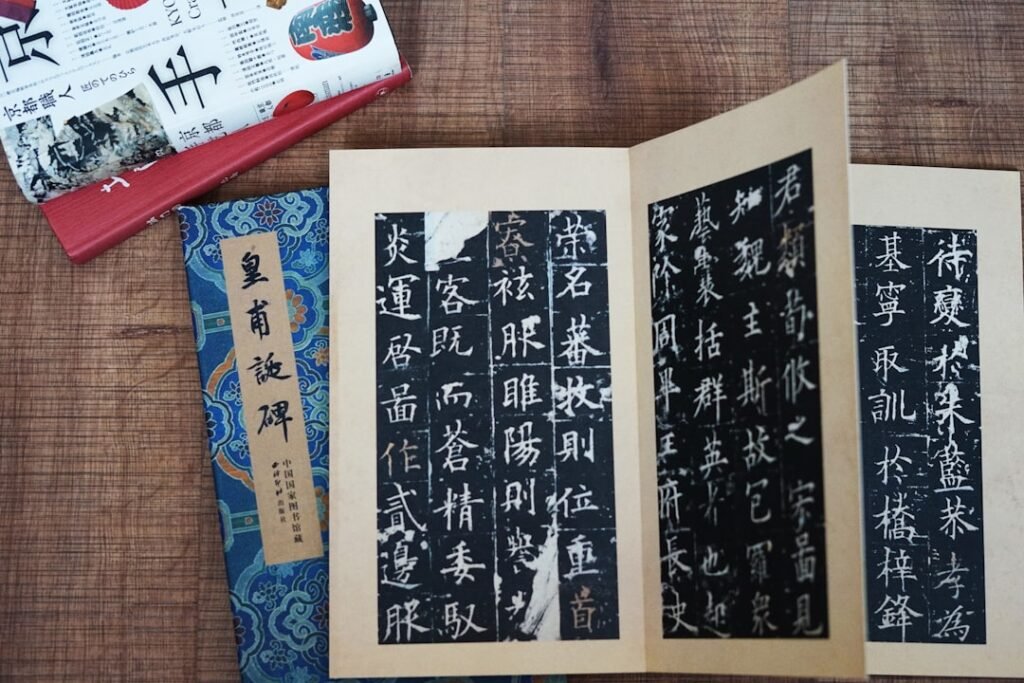Wang Xizhi, often hailed as the Sage of Calligraphy, was born in 303 AD during the Eastern Jin dynasty in Lintao, a region that is now part of modern-day Gansu province. His family belonged to the gentry class, which afforded him a privileged upbringing. From a young age, Wang was exposed to the rich cultural milieu of his time, which included literature, philosophy, and the arts.
His father, Wang Xun, was a notable scholar and official, and it is believed that he played a significant role in nurturing Wang Xizhi’s early interests in writing and calligraphy. The environment in which he grew up was steeped in Confucian values, which emphasised the importance of education and moral integrity. Wang Xizhi’s formal education began at an early age, where he studied the classics and was particularly influenced by the works of earlier calligraphers.
He was known to have been a diligent student, often practicing for hours on end to perfect his technique. His dedication to the art form was evident as he sought inspiration from various sources, including the works of his contemporaries and predecessors. This relentless pursuit of excellence laid the foundation for his future as one of the most revered calligraphers in Chinese history.
His education was not limited to calligraphy; he also delved into poetry and philosophy, which would later inform his artistic expression. Master the art of Chinese calligraphy. Enroll now at the LC Chinese School in Oslo.
Table of Contents
ToggleSummary
- Wang Xizhi was a prominent calligrapher in ancient China, known for his exceptional skill and influence on Chinese calligraphy.
- His masterpiece, the “Orchid Pavilion Preface,” is considered a pinnacle of Chinese calligraphy and has had a lasting impact on Chinese culture and art.
- Wang Xizhi’s calligraphy style and techniques have been studied and emulated by later calligraphers, cementing his legacy in East Asia.
- His contributions to Chinese literature and art have left a lasting historical significance, making him an important figure in Chinese cultural history.
- Wang Xizhi’s enduring popularity and influence on later calligraphers highlight his cultural and historical importance in China.
Wang Xizhi’s Influence on Chinese Calligraphy
Wang Xizhi’s influence on Chinese calligraphy is profound and far-reaching. He is often credited with elevating the art form to new heights, transforming it from a mere utilitarian practice into a revered art that embodies beauty and emotion. His innovative techniques and unique style set a benchmark for future generations of calligraphers.
Wang’s approach to calligraphy was not just about technical skill; it was also about conveying the spirit and essence of the characters he wrote. This philosophical underpinning has made his work resonate deeply with both artists and scholars alike. One of the key aspects of Wang Xizhi’s influence is his development of the semi-cursive script, known as “xingshu.” This style allowed for greater fluidity and expressiveness compared to traditional scripts.
His ability to balance structure with spontaneity has inspired countless calligraphers who sought to emulate his mastery. The elegance and grace found in his strokes are often cited as a source of inspiration for those who wish to explore the depths of calligraphy. Wang Xizhi’s legacy is not merely confined to his own works; it extends to the very fabric of Chinese culture, where calligraphy is regarded as one of the highest forms of artistic expression.
The “Orchid Pavilion Preface” and Wang Xizhi’s Masterpiece

Among Wang Xizhi’s many contributions to calligraphy, the “Orchid Pavilion Preface” stands out as his most celebrated masterpiece. Composed in 353 AD during a gathering of scholars at the Orchid Pavilion in Shaoxing, this work is not only a testament to his technical prowess but also a reflection of his philosophical musings on life and friendship. The preface was written in response to a poetic competition among the attendees, and it eloquently captures the fleeting nature of existence while celebrating the bonds formed through shared experiences.
The “Orchid Pavilion Preface” is renowned for its fluidity and grace, showcasing Wang Xizhi’s ability to infuse emotion into his writing. Each stroke seems to dance across the paper, embodying the very essence of spontaneity and creativity. This piece has been revered throughout history, often regarded as the pinnacle of Chinese calligraphy.
Its aesthetic qualities have inspired generations of artists, while its philosophical depth continues to resonate with readers today. The preface has been copied and studied extensively, becoming a cornerstone in the study of calligraphy and literature alike.
Wang Xizhi’s Impact on Chinese Culture and Art
Wang Xizhi’s impact on Chinese culture extends beyond the realm of calligraphy; he has become an enduring symbol of artistic excellence and intellectual pursuit. His works have been celebrated not only for their aesthetic beauty but also for their philosophical depth, reflecting the values of Confucianism that permeated his society. As a result, Wang Xizhi has become an emblematic figure in Chinese art history, representing the harmonious blend of skill, intellect, and moral integrity.
The influence of Wang Xizhi can be seen in various aspects of Chinese culture, from literature to painting. His writings have inspired poets and scholars who seek to capture the same spirit of spontaneity and depth in their own works. Furthermore, his approach to calligraphy has influenced painters who incorporate calligraphic elements into their art, creating a dialogue between different forms of expression.
This cross-pollination of ideas has enriched Chinese culture, making Wang Xizhi a pivotal figure in its artistic evolution.
The Legacy of Wang Xizhi in East Asia
Wang Xizhi’s legacy transcends geographical boundaries, leaving an indelible mark on East Asian cultures beyond China. His influence can be observed in countries such as Japan, Korea, and Vietnam, where calligraphy has been embraced as an essential aspect of cultural identity. In Japan, for instance, Wang’s techniques were adopted by local calligraphers who sought to emulate his style while infusing it with their own cultural nuances.
This cross-cultural exchange has led to a rich tapestry of calligraphic traditions that continue to thrive today. In Korea, Wang Xizhi’s impact is evident in the development of Hangul calligraphy, where elements of Chinese script were integrated into local practices. His emphasis on fluidity and expressiveness has inspired Korean artists to explore new dimensions within their own calligraphic styles.
Similarly, in Vietnam, where Chinese characters were historically used alongside native scripts, Wang’s influence can be seen in the way Vietnamese calligraphers approached their craft. The enduring popularity of Wang Xizhi’s work across East Asia underscores his significance as a cultural icon whose artistry transcends time and place.
Wang Xizhi’s Calligraphy Style and Techniques

Wang Xizhi’s calligraphy style is characterised by its elegance and fluidity, showcasing a mastery that few have achieved since. His semi-cursive script is marked by sweeping strokes that convey both strength and grace. Unlike rigid forms that prioritise precision over expression, Wang’s technique allows for spontaneity while maintaining structural integrity.
This balance between freedom and control is what sets his work apart from that of his contemporaries. One notable technique employed by Wang Xizhi is the use of varying brush pressure to create dynamic line thicknesses within a single character. This approach adds depth and dimension to his writing, making each piece visually engaging.
Additionally, he often incorporated elements of rhythm into his strokes, allowing them to flow seamlessly across the page. This rhythmic quality not only enhances the aesthetic appeal but also reflects the emotional undertones present in his work. As students at institutions like LC Chinese School in Oslo explore these techniques through dedicated calligraphy courses, they gain insight into the artistry that defines Wang Xizhi’s legacy.
Wang Xizhi’s Contributions to Chinese Literature
Wang Xizhi’s contributions extend beyond visual art; he was also an accomplished writer whose literary works have left a lasting impact on Chinese literature. His poetry often reflects themes of nature, friendship, and introspection—elements that resonate deeply within Chinese literary tradition. The interplay between his written words and calligraphic expression creates a unique synergy that elevates both forms of art.
His literary prowess is perhaps best exemplified in works such as the “Orchid Pavilion Preface,” where he masterfully intertwines poetic imagery with philosophical reflections on life’s transience. This blending of genres has inspired countless writers who seek to emulate his ability to convey profound thoughts through elegant prose. As students delve into both literature and calligraphy at institutions like LC Chinese School in Oslo, they discover how these two disciplines can enrich one another, fostering a deeper appreciation for Wang Xizhi’s multifaceted contributions.
Wang Xizhi’s Influence on Later Calligraphers
The influence of Wang Xizhi on later generations of calligraphers cannot be overstated; he set a standard that many aspired to achieve. His innovative techniques and stylistic choices have been studied extensively by subsequent artists who sought to capture the essence of his mastery while developing their own unique voices. Notable figures such as Yan Zhenqing and Liu Gongquan drew inspiration from Wang’s work, incorporating elements of his style into their own practices.
As time progressed, various schools of thought emerged within the realm of calligraphy, each interpreting Wang Xizhi’s legacy through their own lens. Some sought to replicate his techniques with precision, while others aimed to innovate upon them by blending traditional methods with contemporary influences. This ongoing dialogue between past and present ensures that Wang’s impact remains relevant today as new generations continue to explore the depths of calligraphy.
Wang Xizhi’s Historical Significance in Chinese Art
Wang Xizhi occupies a pivotal position within the historical narrative of Chinese art; he is often regarded as a bridge between ancient traditions and modern expressions. His contributions helped shape not only calligraphy but also broader artistic movements that emerged throughout Chinese history. By elevating calligraphy to an esteemed art form, he paved the way for future artists who would explore new dimensions within this discipline.
His historical significance is further underscored by the reverence with which he is regarded in contemporary society; many view him as a cultural icon whose artistry transcends time. The continued study and appreciation of his work serve as a testament to its enduring relevance within both academic circles and popular culture alike.
The Enduring Popularity of Wang Xizhi’s Calligraphy
The enduring popularity of Wang Xizhi’s calligraphy can be attributed to its timeless beauty and emotional resonance. His works are frequently reproduced in various forms—ranging from traditional scrolls displayed in galleries to modern adaptations found in digital media—ensuring that they remain accessible to audiences worldwide. This widespread appreciation speaks volumes about the universal appeal inherent in his artistry.
Moreover, institutions such as LC Chinese School in Oslo play a crucial role in preserving this legacy by offering courses dedicated specifically to studying Wang’s techniques and philosophies. Through these classes, students not only learn about historical context but also engage with practical exercises that allow them to experience firsthand the beauty of Wang’s style.
Wang Xizhi’s Cultural and Historical Importance in China
Wang Xizhi’s cultural and historical importance within China cannot be overstated; he represents an ideal fusion of artistic talent and intellectual depth that continues to inspire individuals across generations. His contributions have shaped not only the field of calligraphy but also broader cultural narratives surrounding art and literature in China. As students at LC Chinese School in Oslo immerse themselves in learning about this remarkable figure through dedicated courses on Chinese calligraphy, they gain insight into how Wang’s legacy informs contemporary practices while fostering an appreciation for traditional artistry.
In doing so, they become partakers in preserving this rich cultural heritage—ensuring that Wang Xizhi’s influence endures for years to come.
Master the art of Chinese calligraphy. Enroll now at the LC Chinese School in Oslo.







